- News
- Reviews
- Bikes
- Accessories
- Accessories - misc
- Computer mounts
- Bags
- Bar ends
- Bike bags & cases
- Bottle cages
- Bottles
- Cameras
- Car racks
- Child seats
- Computers
- Glasses
- GPS units
- Helmets
- Lights - front
- Lights - rear
- Lights - sets
- Locks
- Mirrors
- Mudguards
- Racks
- Pumps & CO2 inflators
- Puncture kits
- Reflectives
- Smart watches
- Stands and racks
- Trailers
- Clothing
- Components
- Bar tape & grips
- Bottom brackets
- Brake & gear cables
- Brake & STI levers
- Brake pads & spares
- Brakes
- Cassettes & freewheels
- Chains
- Chainsets & chainrings
- Derailleurs - front
- Derailleurs - rear
- Forks
- Gear levers & shifters
- Groupsets
- Handlebars & extensions
- Headsets
- Hubs
- Inner tubes
- Pedals
- Quick releases & skewers
- Saddles
- Seatposts
- Stems
- Wheels
- Tyres
- Health, fitness and nutrition
- Tools and workshop
- Miscellaneous
- Buyers Guides
- Features
- Forum
- Recommends
- Podcast
TECH NEWS
Focus launch new Cayo with disc brake option and electronic/mechanical groupset compatibility on all frames
Focus have today announced the launch of a completely re-designed Cayo including a disc braked version which they say is both the lightest and best-performing carbon disc brake frameset on the market.
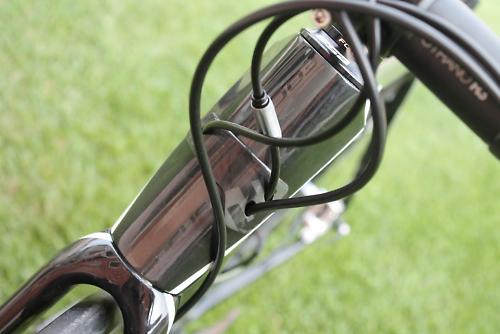
The latest version of the Cayo – a bike designed for those who want to go fast, but not necessarily race at the top level – will be offered for the first time with a disc version as well as a standard calliper braked model. With an average frame weight of 880g across all five sizes, Focus reckon the new Cayo is the lightest carbon framed disc braked bike currently available – they also reckon that its stiffness under braking will make it the top performing disc braked carbon frameset currently available. Never bashful the Germans!
Here’s the full range line-up:
Cayo 1.0 – Shimano Dura-Ace
Cayo 2.0 – Shimano Ultegra Di2
Cayo 3.0 Disc – Shimano Ultegra
Cayo 4.0 – SRAM Force
Cayo 4.0 Disc – SRAM Rival
Cayo 5.0 – Shimano Ultegra
Cayo 6.0 – Shimano Ultegra
Cayo 7.0 –Shimano 105

The new Cayo Disc will be available in both Shimano Ultegra and SRAM Rival versions. Both will come with Focus’s own design of bolt thru axle, the RAT, which we first sat on their Mares cyclocross bike back in February (more on that later) on a very light 380g one-piece carbon fork (the fork on the calliper braked Cayo is only 30g lighter). At the back, Focus have also gone down the route favoured by most other manufacturers for carbon disc equipped bikes by mounting the rear brake on the chainstay inboard of the rear triangle.

Whether you opt for a calliper or disc braked version of the bike, it will be compatible with electronic and mechanical shifting systems. Focus have managed this by using what they’re calling a Cable Routing Plate or CRP. If you want to change your shifting system you simply swap the plate. Simple but clever.
Focus say they believe strongly in disc brakes: "Discs are the future”, was an oft-repeated phrase at the launch. As for user scepticism, the line from the Focus guys is that mountain bikers were sceptical of disc brakes when they first started to appear on off-road bikes over a decade ago – until they tried them.
"We believe strongly in disc brakes," they said, "especially because of carbon fibre rims. Heat from rim brakes can lead to delamination.”
"Disc brakes connected with lightweight rims are a must-have for road bikes."

Of course, disc brakes generate large amounts of heat too, just in a different place. While conceding that 140mm rotors look better, Focus are taking no risks when it comes to dealing with the issue of heat dissipation. The new Cayo frame is compatible only with 160mm rotors front and rear.
Here’s what Focus had to say on the subject in their press pack:
“In conjunction with mountain-bike brake and suspension supplier Magura, Focus tested the differential in heat generation between 140 and 160mm rotors. Under an 800W brake load, the 140mm disc registered 190°C compared to 170°C with the 160mm rotor.
"Hydraulic brake lines become seriously compromised at 190°C and above, so that 20°C difference introduces a comfortable safety margin. Focus took the view that the 30 grams extra weight of the 160mm rotor was a small price to pay to ensure safe and efficient braking.”

Given the lightness of the frame, keeping heat build up in the rotors to a minimum seems sensible. Plus, of course, they have to take in to account the wide variety of conditions the bike can be ridden in: from -20°C to +40°C. "We are the frame makers and it must be safe" we were told. That’s reassuring to know.
Last time we checked, Shimano were still making great play of the heat dissipating abilities of their hydraulic road discs with the IceTech fins derived from their XTR mountain bike discs. Although it has to be said that while Shimano suggest their 140mm rotors for the road is the better option, their take is that 160s are just too powerful. Most manufacturers who spec them have gone down the 160/140 route or, like Focus, gone with 160s front and rear.
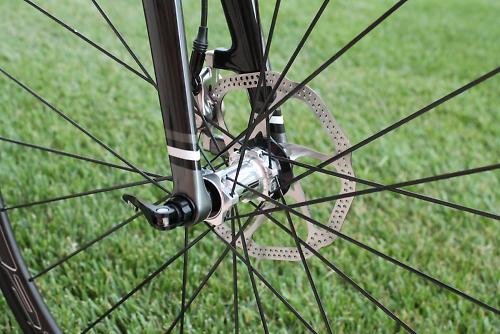
Focus have decided to use thru axles (with closed rather than open dropouts) instead of standard quick release skewers. When it comes to performance road bikes with discs, many manufacturers have gone down this route. First, Giant broke cover with their own design last year, followed earlier this year by both Focus with their Rapid Axle Technology (RAT) axle – on the Mares cyclocross bike (and now the Cayo road bike) – and Trek on the Domane Disc, both with their own proprietary designs.
"We always want to deliver the best performance and for disc brakes there is only one option: thru axle," said Focus engineer Thadeus Tisch. "Besides the higher stiffness that thru axles deliver to the wheels there is another important reason. Thru axles ensure a perfect alignment of the disc rotor between the brake pads and minimise noise. There is nothing more annoying than grinding brakes."

The RAT is an axle with a T-Pin on the end. You fit the T-Pin through the fork and into the insert at the far end, you turn it 90 degrees, then you close the lever (a lot like with a standard QR) and that locks it in place. It takes a couple of seconds. Simple. Smart.
And the performance benefit for racers? Well, when discs are approved for race bikes (yes, 'when' rather than 'if'), Focus claim their RAT axles will make changing wheels faster than can currently be achieved on road bikes with calliper brakes and quick releases – since the pro teams are no longer allowed to file off the lawyer's lips (the safety tabs on the dropouts). The UCI will legalise discs for road racing in 2016, mark our words! They might not know it yet, but they will.
Anway back to the bike – because a good bike is not all about braking. There’s other important stuff too like what it rides like when you’re not braking (we'll have a ride report tomorrow).
The Cayo isn’t Focus’s most successful frame platform because it is the most advanced but because it the one that historically has combined the most technology and performance for the least amount of money... Or, if you prefer, it's the one that gives the biggest bangs per Buck.
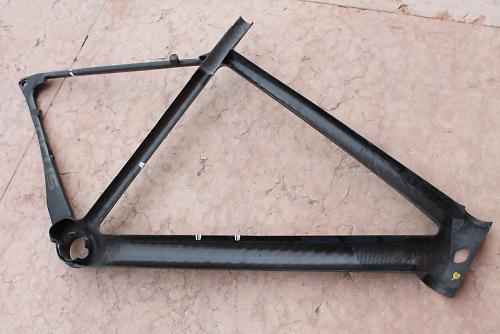
While the new braking options may initially be the most eye-catching aspect of the new bike, it’s the method of frame construction and design that Focus are clearly most pleased about. You can see why given that they set out to produce a lightweight, high-tech machine at a price point.
The Cayo is a bike for going fast on. You can race on it but it hasn’t got quite the super-aggressive geometry of the Izalco, the bike Focus aim at full-on racers. The Cayo's ride position is a touch shorter and more upright than that of the Izalco but the head tube isn't crazy tall like it is on some sportive bikes.
Focus wanted to keep the ride position consistent across all frame sizes, so the stack: reach ratios are the same across the range.
To do that Focus went back to the current model, the Cayo Evo and used its geometry as the starting point to to try to achieve as near constant as a stack to reach* ratio across all sizes of the new model. What they achieved was a stack to reach ratio across the five sizes in the range of 1:1.39 to 1:1.42. By comparison, the more extreme Izalco has a stack to reach ratio of between 1:1.34 or 1.35.
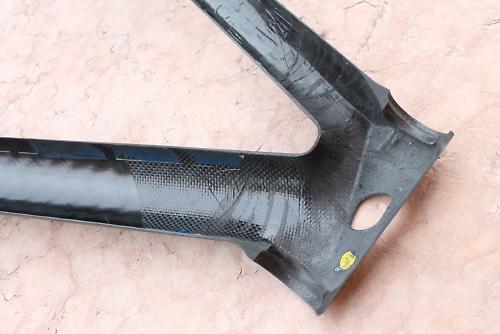
Focus say they wanted to build a bike that delivers stiffness where it counts: at the head tube and bottom bracket. They also wanted to deliver the same stiffness characteristics in every size from 48cm through to 60cm. They've achieved this by varying the diameter of the tubes between sizes, calling this the Stable Stiffness Per Size or SSPS (well, who doesn’t like an acronym?).
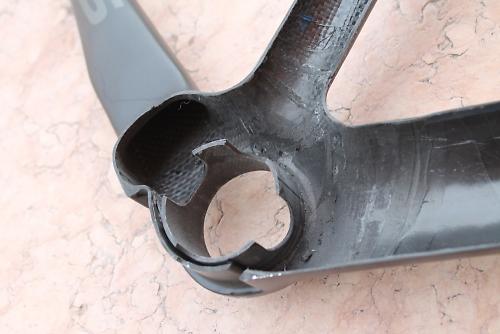
"A tall rider is heavier than a small rider so requires a stiffer frame," according to Focus. "To achieve that greater stiffness more carbon-fibre is used in critical sections like the bottom bracket area. This gives all riders the same Cayo riding experience."
The cleverness doesn’t end there. Focus set themselves the task of building a light, stiff, high performance bike – but, crucially, the Cayo has to deliver on price. The easiest way to deliver a light, stiff road bike is to use high modulus or even ultra high modulus carbon fibre which allows you to get very thin on your tube sections. The downside is that stuff costs.
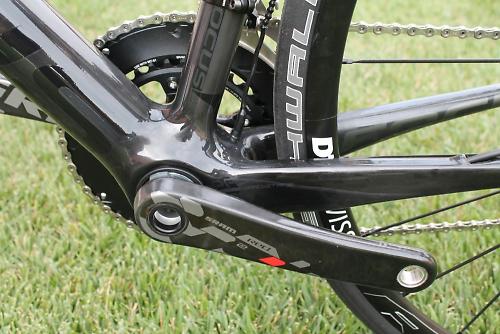
According to Focus, they squared that circle by going for larger tube profiles to add stiffness and strength and using what they call EPS core design. Basically, they designed the inside of the tube profiles as much as the outside, to their own design of carbon layup. That, they reckon, allows them to fine-tune each tube on each frame, eliminating waste and building in strength.
Finally, here are the tech specs for the new Cayo range:
Cayo 1.0
Frame CAYO P2T CARBON
Fork IZALCO P2T CARBON T4
Groupset SHIMANO DURA-ACE
Chainset ROTOR 3D30
Handlebar FIZIK CYRANO R3
Stem FIZIK CYRANO R3
Saddle FIZIK ANTARES NEW
Brakes SHIMANO DURA-ACE
Wheels DT SWISS R20 DICUT
Tyres CAYO P2T CARBON
Cayo 2.0
Frame CAYO P2T CARBON
Fork IZALCO P2T CARBON T4
Groupset SHIMANO ULTEGRA DI2
Chainset SHIMANO ULTEGRA
Handlebar CONCEPT EX
Stem CPX CARBON
Saddle FIZIK ARIONE R7
Brakes SHIMANO ULTEGRA
Wheels FULCRUM WH-CEX 6.5 NEW
Tyres CAYO P2T CARBON
Cayo 3.0 DISC
Frame CAYO P2T CARBON DISC
Fork IZALCO P2T CARBON T4 DISC
Groupset SHIMANO ULTEGRA
Chainset SHIMANO ULTEGRA
Handlebar CONCEPT EX
Stem CPX CARBON
Saddle FIZIK ARIONE R7
Brakes SHIMANO ULTEGRA SR685
Wheels DT SWISS R24 SPLINE TRU-AXLE DISC
Tyres CAYO P2T CARBON DISC
Cayo 4.0
Frame CAYO P2T CARBON
Fork IZALCO P2T CARBON T4
Groupset SRAM FORCE 22
Chainset SRAM FORCE 22
Handlebar FIZIK CYRANO R5
Stem FIZIK CYRANO R5
Saddle FIZIK ARIONE R7
Brakes SRAM FORCE 22
Wheels FULCRUM WH-CEX 6.5 NEW
Tyres CAYO P2T CARBON
Cayo 4.0 Disc
Frame CAYO P2T CARBON DISC
Fork IZALCO P2T CARBON T4 DISC
Groupset SRAM RIVAL 22
Chainset SRAM RIVAL 22
Handlebar CONCEPT EX
Stem CPX CARBON
Saddle FIZIK ARIONE R7
Brakes SRAM RIVAL HDR-A1
Wheels DT SWISS R24 SPLINE TRU-AXLE DISC
Tyres CAYO P2T CARBON DISC
Cayo 5.0
Frame CAYO P2T CARBON
Fork IZALCO P2T CARBON T4
Groupset SHIMANO ULTEGRA
Chainset SHIMANO ULTEGRA
Handlebar CONCEPT EX
Stem CONCEPT EX
Saddle CONCEPT EX
Brakes SHIMANO ULTEGRA
Wheels FULCRUM WH-CEX 6.5 NEW
Tyres CAYO P2T CARBON
Cayo 6.0
Frame CAYO P2T CARBON
Fork FOCUS CRF CARBON T4
Groupset SHIMANO ULTEGRA
Chainset SHIMANO RS500
Handlebar CONCEPT EX
Stem CONCEPT EX
Saddle CONCEPT EX
Brakes CONCEPT R540
Wheels FULCRUM WH-CEX 7.0
Tyres CAYO P2T CARBON
CAYO LTD SHIMANO 105
Frame CAYO P2T CARBON
Fork FOCUS CRF CARBON T4
Groupset SHIMANO 105
Chainset SHIMANO RS500
Handlebar CONCEPT EX
Stem CONCEPT EX
Saddle CONCEPT EX
Brakes CONCEPT R540
Wheels FULCRUM WH-CEX 7.0
Tyres CAYO P2T CARBON
Frame sizes are 48, 51, 54, 57, 60cm.
The Cayo frames are being produced now and the calliper versions will be available first. We do not yet have details on availability or on UK prices.
*Stack = the vertical distance from the centre of the bottom bracket to the top of the head tube.
Reach = the horizontal distance from the centre of the bottom bracket to the top of the head tube.
Mat has been in cycling media since 1996, on titles including BikeRadar, Total Bike, Total Mountain Bike, What Mountain Bike and Mountain Biking UK, and he has been editor of 220 Triathlon and Cycling Plus. Mat has been road.cc technical editor for over a decade, testing bikes, fettling the latest kit, and trying out the most up-to-the-minute clothing. He has won his category in Ironman UK 70.3 and finished on the podium in both marathons he has run. Mat is a Cambridge graduate who did a post-grad in magazine journalism, and he is a winner of the Cycling Media Award for Specialist Online Writer. Now over 50, he's riding road and gravel bikes most days for fun and fitness rather than training for competitions.
Latest Comments
- quadtodd 4 hours 54 min ago
And 3 of the 'workers' are just leaning!
- yellowjack 5 hours 25 min ago
Same sketch everywhere, or so it seems. Take Whitelegg Way in Bournemouth. Wide cycle lanes put in both sides of a (formerly very wide) two lane...
- yellowjack 5 hours 42 min ago
Sounds cool. I haven't taken an "unnecessary flight" since 1992. Flown many times since then for work, but you can't patrol the Iraqi desert, or...
- NOtotheEU 6 hours 5 min ago
My first thought on reading the headline was "ooh, has Clevedon put in covered bike parking now?".
- TheBillder 7 hours 2 min ago
I rented a car a few weeks ago, a Skoda Octavia (needed a big car for a weekend), and the ride was astonishingly good compared to my own 10 year...
- Sriracha 7 hours 58 min ago
Shimano were castigated for not bringing on new factories to meet pandemic demand, thus gumming up the supply chain. Their argument at the time was...
- Romanp 8 hours 8 min ago
I figured out a reason of that squeaking noise. I have xpresso 2 and 7, and also xpro 10 pedals, and that squeaking isn't present only at Xpresso 2...
- MichaelWinnerRIP 9 hours 9 min ago
Italian tourist and pussycat in Portugal.


























Add new comment
23 comments
160mm rear rotors are pointless and will just lead to big flat spots on your rear tyre. I've been running 160/140 on my Volagi for 2.5 years now and descended Alpe D'Huez at 33 Celsius (all 85kg of me) and also hit 60mph on a Cairngorms descent - absolutely no heat issues. It's very easy to snatch a rear brake though because weight transfer on a bike (especially one descending and braking) is pretty extreme with nearly all the weight on the front wheel one the front brake is applied with any force.
You've basically provided a perfect example of one of my concerns. In the wet the effectiveness of the brakes will depend on tyres used. Without a lot of footprint, on a typical 23mm racing bike tyre, disc brakes will result in faster lock ups of back wheels and a greater risk of front wheel lock ups too.
On a motorbike the rear disc is hardly used because of the danger of lock ups and rear end skids. All the braking work is done at the front. Of course a smaller disc at the rear is the usual answer but even then they should have a weaker master cyclinder/piston arrangement. Just watch MotoGP to see how all the braking force is through the front. They do Nose Wheelies all the time.
With respect to your comment about rotor diameters on the rear. If the diameter ratios (front:rear) were the same as a motorbike, such as a ZZR600, a bicycle would have 160:116 to provide a sensible balance. The reason is that under severe braking most people squeeze both levers at the same time and as the rear is always liable to lock the same force at both levers needs to be accentuated in the front and diminished at the back. A 25% smaller rear rotor is heading in the right direction.
The footprint actually makes little difference. Pressure = force/area so, as the area goes down, the pressure goes up. But, with such high pressure, front wheel lock-ups are very tough (just as you don't see them in MotoGP). Rear-wheel lock-ups are relatively benign on a bicycle - just destroy tyres. I've never yet managed to lock my front tyre. With TRP HY/RD on the front, I can't pretty much lift the rear wheel at will (almost MotoGP-like).
Let me allay your concerns, I run discs on my road bike and they don't lead you to lock up more, you adjust very quickly to the increased braking power and then you just brake according to the conditions as you would with any other brake. Where discs are much better in the wet though is that they are a) consistent, so you are always getting the same response to your braking input and b) have much better modulation, so you have a much finer control of the amount of braking force you apply.
The tyre footprint thing is, in my experience, a complete red herring. Bike tyre footprints are too small to aqua plane, so on my conti 4000s I notice no discernible difference in braking power or grip under braking between wet and dry conditions. I've done 15% descents in the hammering rain and braked in the same places as I would in the dry
False. The rear brake is used to control your lean angle on track, and front and rear brakes should be used together in the wet for smoother stopping. Some bikes (honda VFR800) had linked brakes, so it was impossible to brake only the front. Comparing a normal biker who does a few track days (like me) to a moto gp rider is a nonsense. Some people exclusively use the front brake on their motorcycles, they are mssing a valuable tool provided by their machine.
I do however take your point about the rear disc being smaller in diameter than the front. This seems sensible to aid modulation.
The main brake on a road motorbike is the front one, regardless of weather or street/track. The brake force of the front is at least 95% of the total in the dry (and not much less in the wet). You can use the back brake to reduce speed and to steer when entering the corner, however, the lean is only a means for steering (and also needs body movement). This move upsets the suspension and needs a lot of practice to work efficiently (it looks spectacular, even when used inefficiently, but your steering usually gets out of place). So it is rather for pros or motocross. Within the corner, you rather drift to steer and should avoid braking (your foot should not have too much space anyway). And more important than braking is accelerating well out of the corners, especially when there is a long straight.
By the way, Mick Doohan had a special back brake to be used with his thumb after his horrific crash which damaged his right leg. He used it for controlling slides of his back wheel! Pros still like it.
So much about the lean and the valuable tool of the back brake in motorbiking (it is a bit different on bicycles due to different speeds and thus weight distribution when braking, but the basic ratio is the same).
"...there is nothing more annoying than grinding brakes..."
Really?!??
Nigel Farage.
Stepping in dog poo.
Cold Callers (called "Colin") from foreign call centres.
Really bad customer service.
Justin Bieber.
Windows XP.
Cashiers giving you your change on top of a receipt.
Diarrhoea.
Bono.
Piers Morgan.
Trying to find the end of the Sellotape.
There's no bog roll left and it's too late now...
Alanis Morissette.
Burning your toast.
"Press One for Sales..."
Train fares.
Late buses.
Bankers (all of them).
Important calls about my mis-sold Payment Protection Plan.
Michael Gove.
Mr Tumble.
Stampy Chuffing Longlegs
Junk mail.
Bad typography.
Toilets you have to pay for.
Trying to catch the barman's eye if you're a short-arse.
Adverts.
People who smell.
The London Underground.
Valverde's hair.
Kanye West.
Unexpected items in your bagging area.
A flat tyre when you don't have an inner tube or tools with you.
Keep Calm & Carry On.
The sale at DFS.
Pat McQuaid.
Being on hold.
RSS feeds.
Sorry, Out of Stock.
Flies.
Cricket.
Jeremy Paxman.
Spam.
Where are my keys?
(Don't stop me, I'm just getting started here...)
Pmsl (assuming acronyms are not on your extended list
This might just be my next bike.
It looks like that front brake cable might rub on the frame and forks though.
In the area of 10W extra aero drag at 25-30mph?
http://road.cc/content/feature/83327-disc-brakes-v-rim-brakes-which-are-...
It'll be interesting to see where rim design goes, but I suspect there is less to gain from shape/construction savings than you might hope, when you are still designing for clinchers and the extra spoke forces from disc braking....
Real world data says I'm just as fast (if not actually faster) on my Volagi Liscio (discs) than I am my Scott Foil Team Issue (rims). I actually struggle to match flat Strava segment times on the Scott. They're set up to be as close as possible and are running the same tyres. There's certainly not 10W difference.
Is Focus still manufacturing a large majority of their top road bikes in Germany or have the outsourced more models since the MAX? I need to replace my Madone after a car ran over both of us and the Focus brand is on the top of my list.
Any word on tire clearence? Couldn't find it in the text.
Looking at the amount of space above the tyre in that head on view of the headtube and fork - it looks pretty similar to the amount on my Cayo I use for my commute into work along well used country roads, so I needed something to keep all of the rubbish at bay on wet days or even warm sunny days as well.
I have used SKS Raceblades - they use metal brackets trapped behind your brakes and they work well, but if your tyre picks up a substantial piece of crud left behind on the road you could be faced with a broken mudguard and or at minimum another hour lost fiddling around trying to get the guards lined up leaving enough space for your tyres.
I have used Crud Road Racers MkII's and I am glad I discovered them - they keep the maximum amount of the rear wheel enveloped with their multi section assembly and use just a removable zip tie to fix them to the brake and plastic blocks with rubber cords to mount off the seatstays and front fork - Crud Road Racers all the way for me.
Would like to know also, isn't most of the point of discs that they're less compromised by poor conditions or surfaces - where you also want different tyres?
Disc brakes are not affected by wet conditions unlike rim brakes. Furthermore, the mechanical advantage of discs is far superior so stopping power is much improved. These brakes will be the ultimate in braking and as far as cycling goes there will be no better invention. Carbon brakes will never happen because they need to get very hot to work and even motorbikes and cars can't generate the heat for them to be practical for the domestic market.
I'm not convinced that the pro-pelaton will bother with Discs unless there is a clear race advantage and at the moment I can only think of negatives, or at least concerns, that would exclude them if I was a pro cyclist. They may give me a fraction of a second advantage bombing it downhill into a hairpin bend in the dry but in the wet I am more likely to lock up and come off. Hell that already happens with rim brakes so discs will be much worse. They won't improve Bradley's inability to descend fast, that's for sure. The fastest descenders are fast because they don't brake much at all so I doubt discs will appeal to them either.
I think at an amateur/domestic level disc brakes are a great development. Without a doubt, fashion has a part to play in choice of all bike parts so some will want them no matter what. Certainly, in mountain biking I can see a definite advantage over rim brakes. Also on touring bikes or tandems they will be a massive improvement over traditional canti's. I also think for commuting in all weather conditions and in traffic they will be a definite advantage as fast stopping to avoid hazards is something we would all appreciate.
Hi Jakal79
The frame will accommodate 28c tyres (you must be practical and ensure the combination of tyres and wheels you choose fits) and the less common 30c size has also been fitted and run with success.
Does anybody know if there have been test on the extra power needed to pedal bikes with disc brakes compared to bikes with normal rim brakes.
And do disc brakes weight more ?
What? Why would you need more "power" to pedal a bike with disc brakes than rim brakes? Unless you are dragging your brakes?
Yes. A bit when you take entire system (including rotors) into account although that difference will come down/may disappear completely over time as manufacturers strip away (now un-needed) material from the rims.
Any news on when Rival hydros may be available? Cross season is coming.
Talking of ugly things, those SRAM hydraulic levers are truly hideous as well .:evil:
maybe but i love em. comfy, better shift than ever and them hydro brakes..
That is a seriously ugly head tube.
I for one welcome our new Rapid Axle Technology overlords.